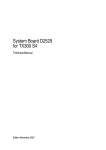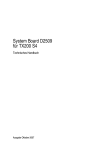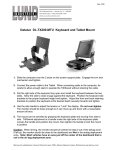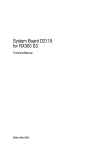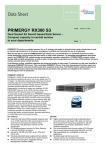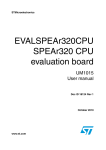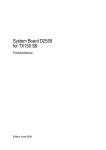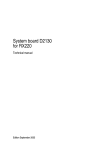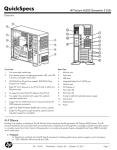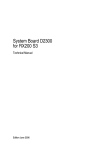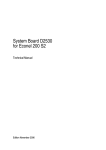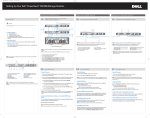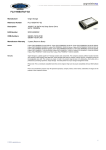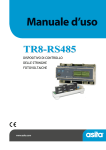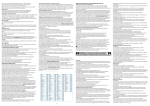Download System Board D2509 for TX200 S4
Transcript
System Board D2509 for TX200 S4 Technical Manual Edition October 2007 Comments… Suggestions… Corrections… The User Documentation Department would like to know your opinion of this manual. Your feedback helps us optimize our documentation to suit your individual needs. Feel free to send us your comments by e-mail to [email protected]. Certified documentation according to DIN EN ISO 9001:2000 To ensure a consistently high quality standard and user-friendliness, this documentation was created to meet the regulations of a quality management system which complies with the requirements of the standard DIN EN ISO 9001:2000. cognitas. Gesellschaft für Technik-Dokumentation mbH www.cognitas.de Copyright and Trademarks Copyright © 2007 Fujitsu Siemens Computers GmbH. All rights reserved. Delivery subject to availability; right of technical modifications reserved. All hardware and software names used are trademarks of their respective manufacturers. Contents 1 Introduction . . . . . . . . . . . . . . . . . . . . . . . . . . . . 5 2 Important notes . . . . . . . . . . . . . . . . . . . . . . . . . . 7 2.1 Notes on safety . . . . . . . . . . . . . . . . . . . . . . . . . . 7 2.2 CE Certificate . . . . . . . . . . . . . . . . . . . . . . . . . . 10 2.3 Environmental Protection . . . . . . . . . . . . . . . . . . . 11 3 Features . . . . . . . . . . . . . . . . . . . . . . . . . . . . . 13 3.1 Overview . . . . . . . . . . . . . . . . . . . . . . . . . . . . 13 3.2 Main memory . . . . . . . . . . . . . . . . . . . . . . . . . . 16 3.3 PCI slots 3.4 Screen resolution 3.5 Temperature / system monitoring . . . . . . . . . . . . . . . 20 3.6 LEDs . . . . . . . . . . . . . . . . . . . . . . . . . . . . . . . 22 3.7 3.7.1 Interfaces and connectors . . . . . . . . . . . . . . . . . . . 24 External ports . . . . . . . . . . . . . . . . . . . . . . . . . . 25 3.8 Settings with switches . . . . . . . . . . . . . . . . . . . . . 27 4 Replacing the lithium battery . . . . . . . . . . . . . . . . . 29 . . . . . . . . . . . . . . . . . . . . . . . . . . . . 17 . . . . . . . . . . . . . . . . . . . . . . . 20 Abbreviations . . . . . . . . . . . . . . . . . . . . . . . . . . . . . . . 31 D2509 (TX200 S4) Technical Manual 1 Introduction This technical manual describes the system board D2509, which can be equipped with one or two Intel® XEON™ processors. Further information about drivers is provided in the readme files on the hard disk, on the supplied “ServerStart“ or “Update“ CDs. You will find further information in the BIOS description. Notational conventions The meanings of the symbols and fonts used in this manual are as follows: italics indicates commands, menu items, file and path names or software programs fixed font indicate system output on the monitor semi-bold fixed font indicates values to be entered through the keyboard [Key symbol] indicates keys according to their representation on the keyboard If capital letters are to be entered explicitly, then the Shift key is shown, e.g. [SHIFT] - [A] for A. If two keys need to be pressed at the same time, then this is shown by placing a hyphen between the two key symbols. “quotation marks” indicates names and terms that are being emphasized. Ê indicates an operation that to be performed V CAUTION! I indicates warnings, which, if ignored, will endanger your health, destroy the system or lead to the loss of data. indicates additional information, notes and tips Table 1: Notational conventions D2509 (TX200 S4) Technical Manual 5 2 Important notes In this chapter you will find essential information regarding safety when working with your server. V CAUTION! With the system board installed you must open the system to access the system board. How to access the system board of your system is described in the appropriate service supplement. When handling the system board, refer to the specific notes on safety in the operating manual and/or service supplement for the respective server. 2.1 Notes on safety V CAUTION! ● The actions described in these instructions should only be performed by authorized, qualified personnel. Equipment repairs should only be performed by qualified staff. Any failure to observe the guidelines in this manual, and any unauthorized openings and improper repairs could expose the user to risks (electric shock, fire hazards) and could also damage the equipment. Please note that any unauthorized openings of the device will result in the invalidation of the warranty and exclusion from all liability. ● Transport the device only in the antistatic original packaging or in packaging that protects it from knocks and jolts. ● Only install expansions that are allowed for the system board. If you install other expansions, you may damage the requirements and rules governing safety and electromagnetic compatibility or your system. Information on which system expansions are suitable can be obtained from the customer service centre or your sales outlet. ● The warranty expires if the device is damaged during the installation or replacement of system expansions. D2509 (TX200 S4) Technical Manual 7 Notes on safety V Important notes ● Components can become very hot during operation. Ensure you do not touch components when making extensions to the system board. There is a danger of burns!. ● Transmission lines to peripheral devices must be adequately shielded. ● To the LAN wiring the requirements apply in accordance with the standards EN 50173 and EN 50174-1/2. As minimum requirement the use of a protected LAN line of category 5 for 10/100 MBps Ethernet, and/or of category 5e for Gigabit Ethernet is considered. The requirements of the specification ISO/IEC 11801 are to be considered. ● Never connect or disconnect data transmission lines during a storm (lightning hazard). Batteries V CAUTION! ● Incorrect replacement of lithium battery may lead to a risk of explosion. The batteries may only be replaced with identical batteries or with a type recommended by the manufacturer. It is essential to observe the instructions in chapter “Replacing the lithium battery”. 8 Technical Manual D2509 (TX200 S4) Important notes Notes on safety Modules with electrostatic-sensitive components Systems and components that might be damaged by electrostatic discharge (ESD) are marked with the following label: Figure 1: ESD label When you handle components fitted with ESDs, you must observe the following points under all circumstances: ● You must always discharge yourself of static charges (e.g. by touching a grounded object) before working. ● The equipment and tools you use must be free of static charges. ● Remove the power plug from the power socket before inserting or removing boards containing ESDs. ● Always hold boards with ESDs by their edges. ● Never touch pins or conductors on boards fitted with ESDs. ● Use a grounding cable designed for this purpose to connect yourself to the system unit as you install/deinstall the board. ● Place all components on a static-safe base. I You will find a detailed description for handling ESD components in the relevant European or international standards (EN 61340-5-1, ANSI/ESD S20.20). D2509 (TX200 S4) Technical Manual 9 CE Certificate Important notes Notes about boards ● During installation/deinstallation of the system board, observe the specific instructions described in the service manual for the server. ● Remove the plug from the mains outlet so that system and system board are totally disconnected from the mains voltage. ● To prevent damage to the system board, the components and conductors on it, please take great care when you insert or remove boards. Take great care to ensure that extension boards are slotted in straight, without damaging components or conductors on the system board, or any other components, for example EMI spring contacts ● Be careful with the locking mechanisms (catches, centring pins etc.) when you replace the system board or components on it, for example memory modules or processors. ● Never use sharp objects (screwdrivers) for leverage. 2.2 CE Certificate The shipped version of this board complies with the requirements of the EEC directive 89/336/EEC "Electromagnetic compatibility". Compliance was tested in a typical PRIMERGY configuration. 10 Technical Manual D2509 (TX200 S4) Important notes 2.3 Environmental Protection Environmental Protection Environmentally friendly product design and development This product has been designed in accordance with standards for ”environmentally friendly product design and development“. This means that the designers have taken into account important criteria such as durability, selection of materials and coding, emissions, packaging, the ease with which the product can be dismantled and the extent to which it can be recycled. This saves resources and thus reduces the harm done to the environment. Notes on saving energy Devices that do not have to be on permanently should not be switched on until they need to be used and should be switched off during long breaks and on completion of work. Notes on packaging Please do not throw away the packaging. We recommend that you do not throw away the original packaging in case you need it later for transporting. Notes on dealing with consumables Please dispose batteries in accordance with local government regulations. Do not throw batteries and accumulators into the household waste. They must be disposed of in accordance with local regulations concerning special waste. All batteries containing pollutants are marked with a symbol (a crossed-out rubbish bin on wheels). In addition, the marking is provided with the chemical symbol of the heavy metal decisive for the classification as a pollutant: Cd Cadmium Hg Mercury Pb Lead Notes on labeling plastic housing parts Please avoid attaching your own labels to plastic housing parts wherever possible, since this makes it difficult to recycle them. D2509 (TX200 S4) Technical Manual 11 Environmental Protection Important notes Returning, recycling and disposal The device may not be disposed of with household rubbish. This appliance is labelled in accordance with European Directive 2002/96/EC concerning used electrical and electronic appliances (waste electrical and electronic equipment - WEEE). The guideline determines the framework for the return and recycling of used appliances as applicable throughout the EU. To return your used device, please use the return and collection systems available to you. You will find further information on this at www.fujitsusiemens.com/recycling. For details on returning and reuse of devices and consumables within Europe, refer to the “Returning used devices” manual, or contact your Fujitsu Siemens Computers branch office/subsidiary or our recycling centre in Paderborn: Fujitsu Siemens Computers Recycling Center D-33106 Paderborn Tel. +49 5251 8 18010 Fax +49 5251 8 18015 12 Technical Manual D2509 (TX200 S4) 3 Features 3.1 Overview Processors – 1 or 2 Intel® Xeon™ processors with socket LGA771 – supported processors: quad-core Intel® Xeon™ 5400 series quad-core Intel® Xeon™ 5300 series dual-core Intel® Xeon™ 5200 series dual-core Intel® Xeon™ 5100 series – 2x VRM 11.0 onboard (EVRD) Main memory – 6 slots for main memory FBD533/PC2-4200F or FDB533/PC2-5300F Fully Buffered DIMM memory modules with 512 MB, 1 Gbyte, 2 Gbyte and 4 Gbyte – Maximum 24 Gbyte of memory (6 memory modules) – Minimum 1 Gbyte (2 memory modules) – Maximum 12.5 or 16 Gbyte/s bandwidth – Supports 2 way interleaved memory subsystems (2 identical memory modules have to installed at the same time) – ECC multiple bit error detection and single bit error correction – Memory scrubbing function – Single Device Data Correction (SDDC) function (Chipkill™) Chips on the system board – – – – – – – – – – Intel® 5000Z chip set Single-channel Gigabit LAN controller (Broadcom 5708C) Service LAN controller (10/100 PHY SMSC 8700) Super I/O controller (SMSC 47M107) 1 MB Flash BIOS Server Management with FSC iRMC VGA controller integrated in iRMC 8MBx16 Flash for iRMC 512KBx16 SRAM for iRMC Thermal and system management controller (ADT7462) D2509 (TX200 S4) Technical Manual 13 Overview Features Internal connectors – – – – – – – – – – – – – – – – – 1 floppy disk connector (34 pin) 1 IDE primary 6 Serial ATA I2C signaling connector SAS activity connector (HD LED) ATX power connector 24 pin (12V, -12V, 5V, 3.3V and 5V auxiliary) ATX power connector 8 pin (2x 12V) ATX power connector 4 pin (1x 12V) PC98 connector front panel dual USB type C (for USB port on front side) 2 USB connectors for optical drives 1 USB connector for internal USB stick 3 connectors for system fans (4 pin) 1 connector for system fan (5 pin) intrusion connector 1 RAID key External connectors – – – – – – 2 serial ports (COM1, COM2) 1 parallel port (optional) 2 PS/2 interfaces for keyboard and mouse 2 USB 2.0 ports with 480 Mbits/s (rear side) 1 VGA port 2 RJ45 LAN ports PCI slots – 2 x PCI-X slots(64 bit / 133 MHz IOOPTM) – 4 x PCI-Express slots, Gen1, mechanical PCIe x8; the slots can be switched in different ways: – 4x PCIe x4 slots (standard) or – 2x PCIe x4 slots and 1x PCIe x8 slot (optional) or – 2x PCIe x8 slots (optional) – 1 x PCI slot 32 bit / 33 MHz) 14 Technical Manual D2509 (TX200 S4) Features Overview BIOS features – – – – – – – – – – – – – Phoenix System-BIOS V 4.06 Rompilot SMBIOS 2.4 (DMI) MultiProcessor Specification 1.4 Server Hardware Design Guide 3.0 WfM 2.0 ACPI 2.0 support USB keyboard/mouse boot possible from: – 120 MB floppy disk drive – CD-ROM/DVD – hard disk – LAN console redirection support OEM logo CPU, memory disable hotspare memory support Environmental protection battery in holder Form factor SSI EEB Baseboard 304,8 x 330,2 mm (12 x 13 inch) CSS (Customer Self Service) This system board supports the CSS functionality. You will find a description of CSS functionality in the operating manual of your server. D2509 (TX200 S4) Technical Manual 15 Main memory 3.2 Features Main memory The system board supports up to 16 Gbyte main memory. 6 slots (3 memory banks with 2 modules) are available for the main memory. Each memory bank can be populated with two 512 Mbyte, 1 Gbyte, 2 Gbyte or 4 Gbyte FBD533/PC2-4200F or FDB667/PC2-5300F fully buffered DIMM memory modules. As in the basic configuration memory bank 1 is populated, the memory extensions can be performed up to two times for memory bank 2 and 3. ECC with memory scrubbing and with the Single Device Data Correction (SDDC) function is supported. I You will find the descriptions how to install memory modules in the Options Guide of your server. Module population DIMM-3B DIMM-2B DIMM-1B DIMM-3A DIMM-2A DIMM-1A Figure 2: Main memory – The memory modules have to be based on x4 or x8 organized single or dual ranked FBD533/PC2-4200F or FDB667/PC2-5300 fully buffered DIMM modules and must be populated in pairs. It is only allowed you use memory modules released by Fujitsu Siemens Computers. – Each pair must consist of identical memory modules (2 way interleaved mode). – The module capacity between pairs can differ: pair 1A/1B can be populated with two 512 Mbyte modules and pair 2A/2B with two 1 Gbyte modules. 16 Technical Manual D2509 (TX200 S4) Features PCI slots Following table shows the mandatory population order: module pair 1A/1B (black) module pair 2A/2B (blue) module pair 3A/3B (blue) populated empty empty populated populated empty populated populated populated 3.3 PCI slots Slot 7 PCIe x8 7 Slot 6 PCIe x8 6 Slot 5 PCI-X 64 Bit / 133 MHz IOOP TM 5 Slot 4 PCI-X 64 Bit / 133 MHz IOOP TM 4 Slot 3 PCI 32 Bit / 33 MHz 3 Slot 2 PCIe x8 2 Slot 1 PCIe x8 1 Figure 3: Mechanical PCI slots D2509 (TX200 S4) Technical Manual 17 PCI slots Features PCI slots The following table shows an overview of the PCI slots: PCI slot Type mechanical Function 1 PCIe x8 PCIe x4 or PCIe x8 slot (optional) 2 PCIe x8 PCIe x4 slot or not available if slot 1 x8 (optional) 3 PCI 32 32-bit PCI slot 4 PCI-X 64 5 PCI-X 64 64-bit PCI-X slot 133 MHz if only one card has been populated in slot 4 or 5 100 MHz for population with 2 cards 6 PCIe x8 PCIe x4 or PCIe x8 slot (optional) 7 PCIe x8 PCIe x4 slot or not available if slot 6 x8 (optional) IOOP™ (PCI bus speed optimization) The hardware of the system board optimizes the PCI bus speed of the slots 4 and 5, depending on the slots’ population. – the PCI bus speed is 133 MHz, if only one of the two slots (or no slot) is populated. – the PCI bus speed is 100 MHz for all other population variants for slot 4 and 5. PCI, PCI-X, PCI Express interrupts Each device connected to a PCI bus, a PCI-X bus or PCI Express can use up to four interrupt signals depending on the functionality. PCI and PCI-X buses use four lines named INTA to INTD, typically connected to all devices on the bus in order to periodically balance interrupt load. An interrupt signal may thereby be used simultaneously by multiple devices (interrupt sharing). PCI Express devices send their interrupts through messages. The interrupts are defined by the system design. 18 Technical Manual D2509 (TX200 S4) Features PCI slots The following interrupt signals are used in the system: Slot/device Property Interrupt signal VGA iRMC graphic PCI-INTA LAN BCM5708c Single Channel PCI-INTB Slot 7 PCIe x8 PCI_INTA, PCI_INTB, PCI_INTC, PCI_INTD Slot 6 PCIe x8 PCI_INTA, PCI_INTB, PCI_INTC, PCI_INTD Slot 5 PCI-X (133 MHz) PCI-X-INTC, PCI-X-INTD, PCI-X-INTA, PCI-X-INTB Slot 4 PCI-X (133 MHz) PCI-X-INTA, PCI-X-INTB, PCI-X-INTC, PCI-X-INTD Slot 3 PCI (33 MHz) PCI-INTC, PCI-INTD, PCI-INTA, PCI-INTB Slot 2 PCIe x8 PCI_INTA, PCI_INTB, PCI_INTC, PCI_INTD Slot 1 PCIe x8 PCI_INTA, PCI_INTB, PCI_INTC, PCI_INTD Assignment of the PCI interrupts If you select Auto in the BIOS setup, the interrupts are assigned automatically and no further settings are required. D2509 (TX200 S4) Technical Manual 19 Screen resolution 3.4 Features Screen resolution Depending on the operating system used the screen resolutions in the following table refer to the graphic controller on the system board. The graphic controller is integrated in the iRMC (integrated Remote Management Controller). Screen resolution Supported colors 640x480 8 bit, 16 bit, 24 bit 800x600 8 bit, 16 bit, 24 bit 1024x768 8 bit, 16 bit, 24 bit 1152x864 8 bit, 16 bit, 24 bit 1280x1024 8 bit, 16 bit, 24 bit 1600x1200 8 bit, 16 bit If you are using an external graphic controller, you will find details of supported screen resolutions in the operating manual or technical manual supplied with the graphic controller. 3.5 Temperature / system monitoring Temperature and system monitoring aim to reliably protect the computer hardware against damage caused by overheating. In addition, any unnecessary noise is also prevented by reducing the fan speed, and information is provided about the system status. The following functions are supported: Temperature monitoring Measurement of the processor and the system internal temperature by an onboard temperature sensor, measurement of the ambient temperature by a I2C temperature sensor. Fan monitoring The CPU, power supply unit and system fans are monitored. Fans that are no longer available, blocked or sticky fans are detected. 20 Technical Manual D2509 (TX200 S4) Features Temperature / system monitoring Fan control The fans are regulated according to temperature. Sensor monitoring The removal of, or a fault in, a temperature sensor is detected. Should this happen all fans monitored by this sensor run at maximum speed, to achieve the greatest possible protection of the hardware. Voltage monitoring When voltage exceeds warning level high or falls below warning level low an alert will be generated. Cover monitoring Unauthorized opening of the cover is detected, even when the system is switched off. However, this will only be indicated when the system is switched on again. System Event Log (SEL) All monitored events of the system board are signalized via the Global Error LED and recorded in the System Event Log. They could be retrieved in the BIOS Setup or via ServerView. PRIMERGY Diagnostic LEDs Optical signaling through the LEDs on the system board identifies defective modules and components as well as gaining information on the PDA. D2509 (TX200 S4) Technical Manual 21 LEDs 3.6 Features LEDs AE B C G Super I/O DIMM3B DIMM2B CPU 1 DIMM1B DIMM3A G DIMM2A DIMM1A FF LAN H F CPU 2 MCH PCIe x8 PCIe x8 ON H H iRMC PCI-X 64 Bit / 133 MHz IOOPTM 1 2 3 4 PCI-X 64 Bit / 133 MHz IOOPTM Indicate CSS PCI 32 Bit / 33 MHz H PCIe x8 F PCIe x8 D1 - D4 Figure 4: LEDs LED s A, B and C are visible from outside on the rear of the server. All the other LEDs are only visible, if the cover of the server has been opened. If the server has been powered off (power-plugs must be disconnected) it is possible to indicate the faulty component by pressing the indicate CSS button. 22 Technical Manual D2509 (TX200 S4) Features LEDs The LEDs have the following meaning: LED Indicator Meaning A - Identification blue server is identified via ServerView B - CSS (Customer Self Service) yellow indicates a prefailure yellow flashing indicates a failure C - GEL (Global Error LED) orange indicates a prefailure D1 - board yellow aux. voltage available D2 - board green system running D3 - board red configuration error. The system board will be held in reset. Possible configuration errors are e.g.: old CPU populated, CPUs with different FSB requirements populated, CPU1 not populated D4 - board green flashing iRMC - server management controller is ok off iRMC not alive off memory module running orange memory module failure off fan running orange fan failure E - memory F - system fans G - CPU fans H - PCI card D2509 (TX200 S4) orange flashing indicates a failure. Reasons for a failure may be: - overheating of one of the sensors - sensor defect - fan defect - CPU error - Software detected an error off fan running orange fan failure off PCI card okay orange PCI card failure Technical Manual 23 Interfaces and connectors 3.7 Features Interfaces and connectors 1 2 3 4 5 Super I/O DIMM3B DIMM2B 25 CPU 1 DIMM1B DIMM3A DIMM2A DIMM1A MCH 24 23 6 7 CPU 2 8 9 PCIe x8 LAN PCIe x8 ON PCI-X 64 Bit / 133 MHz IOOPTM 22 1 2 3 4 PCI-X 64 Bit / 133 MHz IOOPTM PCI 32 Bit / 33 MHz iRMC PCIe x8 10 11 12 13 14 15 PCIe x8 21 20 19 18 17 16 Figure 5: Schematic view of the system board D2509 1 = Printer (optional) 14 = Intrusion 2 = Power supply PWR1 15 = Floppy disk drive 3 = Power supply PWR3 16 = SATA MLC1 4 = Slots for main memory modules 17 = SATA 5 5 = Power supply PWR2 18 = SATA 6 6 = USB stick 19 = Battery 7 = System fan 1 20 = System fan 2 8 = PC98 21 = RAID key (SATA SW RAID) 9 = Front panel 22 = PCI slots 24 Technical Manual D2509 (TX200 S4) Features Interfaces and connectors 10 = USB Front 23 = System fan 3 11 = DIP switch (see page 27) 24 = Redundant system fan 4 12 = USB1 AUX 25 = External ports 13 = USB2 AUX RAID key The SATA SW RAID 5 functionality will be activated by installing a license key (RAID key). 3.7.1 External ports 2 3 10 9 4 1 7 6 8 5 Figure 6: External ports of the system board D2509 1 = CSS LED (yellow) Global Error LED (orange) Identifications LED (blue) 6 = USB port 2 = PS/2 mouse connector 7 = USB port 3 = serial interface COM2 8 = VGA port 4 = LAN connector 1 (service LAN) 9 = serial interface COM1 5 = LAN connector 2 10 = PS/2 keyboard connector The serial interface COM1 can be used as default interface or to communicate with the iRMC. D2509 (TX200 S4) Technical Manual 25 Interfaces and connectors Features LAN connectors On this system board you will find two LAN controllers: a single-channel Gigabit LAN controller and a service LAN controller. The single-channel Gigabit LAN controller supports the transfer rates of 10 Mbit/s, 100 Mbit/s and 1 Gbit/s. The Service LAN controller supports the transfer rates of 10 Mbit/s and 100 Mbit/s. The LAN controllers support WOL function through Magic Packet™. It is also possible to boot a device without its own boot hard disk via LAN. Intel PXE or iSCSI Boot can be used. The LAN1 port serves as management interface and is prepared for RemoteView. The LAN connectors are equipped each with two LEDs (light emitting diode) indicating the transfer rate and the activity. 2 1 Figure 7: LAN connector single-channel Gigabit LAN controller 1 LAN transfer rate green + yellow 2 LAN link/activity 26 off transfer rate 10 Mbit/s green on transfer rate 100 Mbit/s yellow on transfer rate 1000 Mbit/s green on LAN connection off no LAN connection flashing LAN transfer Technical Manual D2509 (TX200 S4) Features Settings with switches 2 1 Figure 8: LAN connector service LAN controller 1 LAN transfer rate green off transfer rate 10 Mbit/s green on transfer rate 100 Mbit/s green on LAN connection off no LAN connection flashing LAN transfer 2 LAN link/activity 3.8 Settings with switches ON 1 2 3 4 Figure 9: DIP switch I Preset for switches 1 to 4 = Off. Recovering System BIOS - switch 1 Switch 1 enables recovery of the old system BIOS after an attempt to update has failed. To restore the old system BIOS you need a Flash BIOS Diskette (please call our customer service centre). on The system boots from the “Flash BIOS floppy disk“ from drive A and reprograms the system BIOS on the board. off The System BIOS is started with the system BIOS from the system board (default setting). D2509 (TX200 S4) Technical Manual 27 Settings with switches Features Skipping the password query - switch 2 Switch 2 is used to define whether the password is queried at system startup, if the password protection is enabled in BIOS Setup (in Security menu, the Password field must be set to Enabled). on The password query is skipped. Passwords are deleted. off The password query is effective (default setting). Write protection for Flash BIOS - switch 3 Switch 3 is used to define whether the System BIOS is write protected or not. on The System BIOS can neither be written to nor deleted. Flash-BIOS update from floppy disk is not possible. off The System BIOS can be written or deleted. Flash-BIOS update from floppy disk is possible (default setting) Write protection for floppy disks - switch 4 Switch 4 is used to define whether floppy disks can be written or deleted in the floppy disk drive. To write and delete floppy disks, the write-protection in BIOS Setup must be disabled (in menu Security, the field Diskette Write must be set to Enabled). on The floppy disk drive is write-protected. off Floppy disks can be read, written and deleted (default setting). 28 Technical Manual D2509 (TX200 S4) 4 Replacing the lithium battery In order to save the system information permanently, a lithium battery is installed to provide the CMOS-memory with a current. When the charge is too low or the battery is empty, a corresponding error message is provided. The lithium battery must then be replaced. V The lithium battery must be replaced with an identical battery or a battery type recommended by the manufacturer (CR2450). Do not throw lithium batteries into the trash can. It must be disposed of in accordance with local regulations concerning special waste. Make sure that you insert the battery the right way round. The plus pole must be on the top! 4 2 3 1 Figure 10: Replacing the lithium battery Ê Press the locking spring into direction of the arrow (1), so that the lithium battery jumps out of its socket. Ê Remove the battery (2). Ê Insert a new lithium battery of the same type into the socket (3) and (4). D2509 (TX200 S4) Technical Manual 29 Abbreviations The technical terms and abbreviations given below represent only a selection of the full list of common technical terms and abbreviations. Not all technical terms and abbreviations listed here are valid for the described system board. ACPI Advanced Configuration and Power Interface ASR&R Automatic Server Recovery and Restart ATA Advanced Technology Attachment BBU Battery Backup Unit BIOS Basic Input Output System BMC Baseboard Management Controller CMOS Complementary Metal Oxide Semiconductor COM COMmunication port CPU Central Processing Unit DDR Double Data Rate DIMM Dual In-line Memory Module D2509 (TX200 S4) Technical Manual 31 Abbreviations DIP Dual In-line Package DMI Desktop Management Interface DRAM Dynamic Random Access Memory ECC Error Correction Code EEPROM Electrical Erasable Programmable Read Only Memory EPROM Erasable Programmable Read Only Memory EMRL Embedded RAID Logic EVRD Enterprise VRD HPC Hot-plug Controller ICE In Circuit Emulation IDE Integrated (intelligent) Drive Electronics IME Integrated Mirror Enhanced IOOP Intelligent Organization Of PCI IPMB Intelligent Platform Management Bus 32 Technical Manual D2509 (TX200 S4) Abbreviations IPMI Intelligent Platform Management Interface iRMC integrated Remote Management Controller LAN Local Area Network LED Light Emitting Diode MPS Multi Processor Specification NMI Non Maskable Interrupt OEM Original Equipment Manufacturer OHCI Open Host Controller Interface OS Operating System PCI Peripheral Components Interconnect PDA Prefailure Detection and Analyzing PIO Programmed Input Output PLD Programmable Logic Device PS(U) Power Supply (Unit) D2509 (TX200 S4) Technical Manual 33 Abbreviations PWM Puls Wide Modulation PXE Preboot eXecution Environment RAID Redundant Array of Inexpensive Disks RSB Remote Service Board RST ReSeT RTC Real Time Clock SAS Serial Attached SCSI SATA Serial ATA SCSI Small Computer Systems Interface SDDC Single Device Data Correction SDRAM Synchronous Dynamic Random Access Memory SHDG Server Hardware Design Guide SMB System Management Bus SMM Server Management Mode 34 Technical Manual D2509 (TX200 S4) Abbreviations SMP Symmetrically Multi Processing UHCI Unified Host Controller Interface USB Universal Serial Bus VGA Video Graphics Adapter VRD Voltage Regulator Down VRM Voltage Regulator Module WfM Wired for Management WOL Wake up On LAN D2509 (TX200 S4) Technical Manual 35 Information on this document On April 1, 2009, Fujitsu became the sole owner of Fujitsu Siemens Computers. This new subsidiary of Fujitsu has been renamed Fujitsu Technology Solutions. This document from the document archive refers to a product version which was released a considerable time ago or which is no longer marketed. Please note that all company references and copyrights in this document have been legally transferred to Fujitsu Technology Solutions. Contact and support addresses will now be offered by Fujitsu Technology Solutions and have the format …@ts.fujitsu.com. The Internet pages of Fujitsu Technology Solutions are available at http://ts.fujitsu.com/... and the user documentation at http://manuals.ts.fujitsu.com. Copyright Fujitsu Technology Solutions, 2009 Hinweise zum vorliegenden Dokument Zum 1. April 2009 ist Fujitsu Siemens Computers in den alleinigen Besitz von Fujitsu übergegangen. Diese neue Tochtergesellschaft von Fujitsu trägt seitdem den Namen Fujitsu Technology Solutions. Das vorliegende Dokument aus dem Dokumentenarchiv bezieht sich auf eine bereits vor längerer Zeit freigegebene oder nicht mehr im Vertrieb befindliche Produktversion. Bitte beachten Sie, dass alle Firmenbezüge und Copyrights im vorliegenden Dokument rechtlich auf Fujitsu Technology Solutions übergegangen sind. Kontakt- und Supportadressen werden nun von Fujitsu Technology Solutions angeboten und haben die Form …@ts.fujitsu.com. Die Internetseiten von Fujitsu Technology Solutions finden Sie unter http://de.ts.fujitsu.com/..., und unter http://manuals.ts.fujitsu.com finden Sie die Benutzerdokumentation. Copyright Fujitsu Technology Solutions, 2009





































